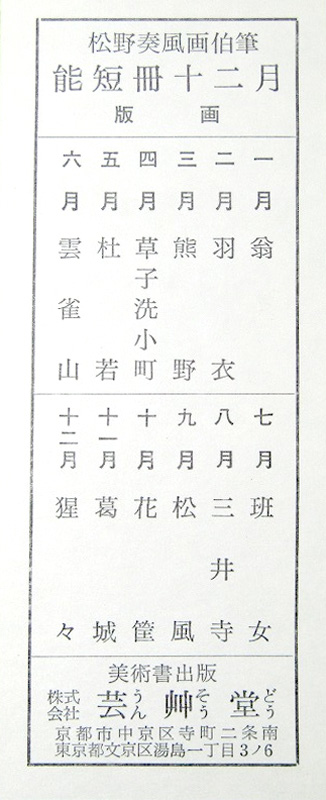About This Print and Twelve Months of Noh Tanzaku
"Okina is the oldest and most sacred piece in the Noh repertoire, but unlike other pieces, Okina is more like a set of dances than a full play. The piece prays for good harvest and longevity, and it is based on the rituals of traditional Japanese ceremonies. It is even said that the principle actors of Okina are possessed by the presence of a god throughout the duration of the performance."2
Twelve Months of Noh Tanzaku
From an undated set of twelve prints depicting twelve Noh plays, one play for each month, published by Unsōdō Publishing. This set likely preceded the set of prints with a similar name Twelve Months of Noh Pictures designed by Matsuno Sōfū (1899-1963) and his son Matsuno Hideyo (1936-2002). The print set, as stated in its title, was designed in the tanzaku format, a long and narrow pillar format originally used for poem cards and offerings. Each print presents the main character in a noh play in a truncated profile, allowing the viewer to complete the picture for each well known play.
In this set, reference image shown below, each print is mounted on a stiff board, the verso of which contains the prints title. The colophon for the set is shown below.
松野奏風画伯筆 能短冊十二月 版画
Twelve Months of Noh Tanzaku by Matsuno Sofu, Woodblock Prints
一月 翁; 二月 羽衣; 三月 熊野; 四月 草子洗小町; 五月 杜若; 六月 雲雀山; 七月 班女; 八月 三井寺;九月 松風; 十月 花筐; 十一月 葛城; 十二月 猩々
January Okina; February Hagoromo; March Yuya; April Sōshi Arai Komachi; May Kakitsubata; June Hibariyama; July Hanjo; August Miidera; September Matsukaze; October Hanagatami; November Kazuraki; December Shōjō
美術書出版
株式会社 芸艸堂
京都市中京区寺町二条南
東京都文京区湯島一丁目 3-6
Art Book Publishing
Unsōdō Public Company
Kyoto City address
Tokyo address
The Play - Okina
Source: A Guide to No, P.G. O'Neill, Hinoki Shoten, 1929, p.132-133.
All schools
Characters:
Kanze and Hōshō schools: Bearer of the mask (kyōgen role); Okina, Senzai, Sambasō (kyōgen role)
Komparu, Kongō and Kita schools: Senzai, bearer of the mask (kyōgen role); Okina; Sambasō (kyōgen role)
Okina is a piece quite distinct in character from any other Nō play. Consisting of little more than a group of dances which are said to have been in existence in the tenth century, its history is certainly much older than that of any other Nō. Throughout its history it has had a religious significance which still exists today. With words and dances designed to win the help of the gods in obtaining peace and prosperity in the land and long life for its people, Okina is performed only at times of special celebration or commemoration. When it is given, it is always performed first and the part of Okina is usually played the iemoto, the head of the school. Before the players come on to the stage a ceremony of purification is performed in the dressing-room from which women are strictly excluded. The performance consists of four main parts:
1. Sung part by Okina and chorus
2. Dance by Senzai
3. Dance by Okina
4. Dance by Sambasō - First part, unmasked; Second part, with mask and bells.
1 Small vertical poem cards, approximately 36cm long x 6cm wide that may be decorated with colored designs, sprinkled with cut gold, silver or mica or covered with silk. The origins of this form may be connected to small slips of paper used for divining in ancient times. Another possible origin of tanzaku comes from the Heian period, when small rectangular pieces of paper, on which one poem was written, were used for poetry anthologies. The earliest extant examples from the 14c are of waka 和歌 poems on tanzaku white with no decoration. It was during the Muromachi period that tanzaku became highly decorated with cloud patterns overlaid with cut pieces of gold and silver. [source: Japanese Architecture and Art Net Users System.]2 Scripps College Ruth Chandler Williamson Gallery website http://web-kiosk.scrippscollege.edu/Obj20745?sid=171248&x=15207311
Print Details
| IHL Catalog | #2403 |
| Title | Okina (January) 翁 (一月) title printed verso  |
| Series/Album | Twelve Months of Noh Tanzaku 能短冊十二月 Noh tanzaku jūnikagetsu |
| Artist | Matsuno Sōfū (1899-1963) |
| Signature |  |
| Seal | 奏 Sō |
| Date | unknown, but likely 1950-early 1960s |
| Edition | unknown |
| Publisher | Unsōdō Publishing 芸艸堂 版 |
| Carver | unknown |
| Printer | unknown |
| Impression | excellent |
| Colors | good |
| Condition | fair - extensive foxing |
| Genre | nishiki-e; Nōgaku zue [Noh play picture] |
| Miscellaneous | |
| Format | tanzaku |
| H x W Paper | 14 1/4 x 2 7/8 in. (36.2 x 7.3 cm) |
| Collections This Print | |
| Reference Literature |
12/7/2020 created




